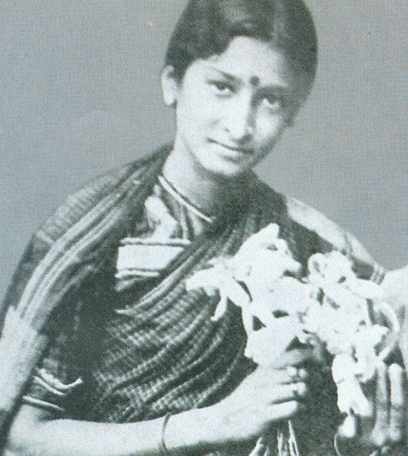
Kamalabai Gokhale
|
AFTER
''RAJA HARISHCHANDRA''
With the stupendous success of 'Raja Harishchandra' and with the hope of settling down in
the new medium Dadasaheb Phalke made a daring move. He had realised that he could not
really concentrate on his filmmaking work in the city of Bombay, which had already become
a leading commercial city of India. Besides, the environs of Bombay could not give him the
atmosphere that he wanted for his films. Thus, on October 3, 1913, he shifted to his
''native'' Nasik which provided him with just such an environment.
Within three months of shifting to Nasik, Phalke had produced his second mythological film
'Mohini Bhasmasur'. This film was slightly shorter than his previous film and ran upto a
length of 3245 feet. For the first time Phalke had also been able to secure the services
of two actresses : a mother and daugther duo, Durga and Kamala, who played the roles of
Mohini and Parvati in the film, thus becoming the first women artiste of Indian cinema.
( Incidentally, Kamala was Kamalabai Gokhale whose son Chandrakant Gokhale and grandson
Vikram Gokhale were to dominate Marathi cinema in later years). As a side attraction with
this feature Phalke produced a short comedy 'Pithache Panje' or 'Hand Prints', which told
the story of a philandering husband caught in a compromising situation by his wife - a
subject which generated a controversy in the press.
With his two films proving to be box office and critical success, there were an increasing
number of enquiries for more Phalke films. With his studio ( or ''factory" as he
reffered to it) already set into motion and a core staff of faithfuls trained in the
technique of cinema, it was not a difficult task for Phalke to oblige. His third film
"Satyawan Savitri" was ready in the next three months and released in June 1914.
The revenue from a single print of each of the first three films was enough to pay for
Phalke's accumalated liabilities.
By 1914 success for Phalke was almost axiomatic. Financiers were willing to invest any
amount of money into his ventures. Distributors all over India were keen on acquiring sole
agency rights over his films. He had even become famous abroad and there was always
a ready demand for 20 copies of each of his films. Phalke decided that it was now
time to expand by investing another Rs. 25,000 to Rs. 30,000 to buy new electricity-driven
machinery. phalke decided to go abroad again, not only to buy this equipment but also to
see if he could hold trade shows and exploit his films abroad.
Phalke's 1914 visit to London was quite different from his previous visit. This time he
was not as friendless as he was last time. In fact, thanks to Cabourne's references to him
in the 'Bioscope' he had become a minor celebrity. Cabourne added to this by mentioning
about Phalke's arrival in the May 28, 1914 issue of the 'Bioscope', tus creating a little
curiosity about the Indian filmmaker. On his arrival in London, Phalke held the trade
shows of his first three films as planned and, as expected, the films were accorded a warm
response. He was even approached by a couple of British producers who offered him a free
hand plus a handsome remuneration of 300 pounds a month and a 20 percent share in the
profits if he stayed back to make films on Indian themes. Phalke, already an enthusiastic
supporter of Lokmanya Tilak's Swadeshi movement, refused these tempting offers and set
sail for India.
|